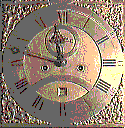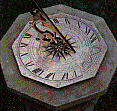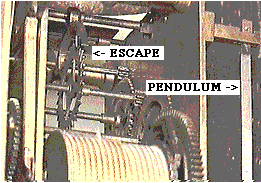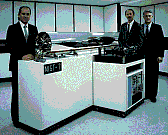


 |
 KEEPING TIME
KEEPING TIME
Whether we are observing the changing of the seasons or sensing our own heartbeat we are conscious of the passage of time as periodic phenomena repeat themselves around us. To keep track of the passage of time we invent tools, such as calendars and timepieces. Sometimes the tools are impressive as the monumental stone piles at
Stonehengesometimes they are mundane as the wristwatch we wear.
Over the years timepieces have included sundials and other objects that can throw a shadow, continuous phenomena that occur at constant rate (dripping water in water clocks), swinging pendulums in grandfather clocks, electric motors and quartz crystals.
In principle, any periodic phenomenon in nature can provide counting a mechanism to mark the passage of time. This article will provide an introduction to this subject. Detailed discussion of the issues we raise here are available throughout the web. Just follow the links in the article.
 The daily spinning of the Earth gives rise to the apparent motion of the Sun, rising in the East and setting in the West. The time interval between two successive passage of the Sun overhead is called the apparent solar day. From the spinning Earth one can also observe an apparent motion of the fixed (far away) stars. The time interval between two successive passages of a star is called the sidereal day.
The daily spinning of the Earth gives rise to the apparent motion of the Sun, rising in the East and setting in the West. The time interval between two successive passage of the Sun overhead is called the apparent solar day. From the spinning Earth one can also observe an apparent motion of the fixed (far away) stars. The time interval between two successive passages of a star is called the sidereal day.
 The search for such devices has a colorful and interesting
history.
The earliest known clocks used the periodicity of the spinning Earth. The motion of the sun across the sky can be monitored by the shadow thrown by terrestrial objects. The earliest such
sundial
is a vertical stick called the gnomon, placed on a horizontal base. A scale oriented along the east-west direction is used to tell the time of day. In the pre-noon hours the shadow is on the west side of the gnomon, in the afternoon the shadow is on the east side. Later sundials had elaborate faces and were mounted vertically or horizontally. Apart from the fact that a sundial is useless on cloudy days and at night, the scale has to be devised with elaborate corrections for the location and for the time of the year. The Greeks. known for their geometrical sophistication, constructed sundials of considerable complexity. The advent of mechanical clocks eventually made sundials obsolete as practical timekeeping devices although their are still widely used for ornamental purposes. The sundial in the picture can be purchased from
Sundials For The Connoiseur .
The search for such devices has a colorful and interesting
history.
The earliest known clocks used the periodicity of the spinning Earth. The motion of the sun across the sky can be monitored by the shadow thrown by terrestrial objects. The earliest such
sundial
is a vertical stick called the gnomon, placed on a horizontal base. A scale oriented along the east-west direction is used to tell the time of day. In the pre-noon hours the shadow is on the west side of the gnomon, in the afternoon the shadow is on the east side. Later sundials had elaborate faces and were mounted vertically or horizontally. Apart from the fact that a sundial is useless on cloudy days and at night, the scale has to be devised with elaborate corrections for the location and for the time of the year. The Greeks. known for their geometrical sophistication, constructed sundials of considerable complexity. The advent of mechanical clocks eventually made sundials obsolete as practical timekeeping devices although their are still widely used for ornamental purposes. The sundial in the picture can be purchased from
Sundials For The Connoiseur .
 Sometime in the 14th century striking public mechanical clocks appeared. The clock at the Salisbury cathedral in England dates from 1386. This clock was built 300 years before Galileo noticed the periodic motion of the pendulum!
Sometime in the 14th century striking public mechanical clocks appeared. The clock at the Salisbury cathedral in England dates from 1386. This clock was built 300 years before Galileo noticed the periodic motion of the pendulum! In the early clocks (pre-1650) the oscillating object was a horizontal bar called a foliot, mounted on a vertical spindle. The bar was connected to a toothed wheel, called a crown wheel, the teeth of which periodically bumped the crossbar. Such a mechanism later became known as an escapement. The wheel is driven by a falling weight whose potential energy gets converted into the kinetic energy of the oscillator. These early oscillators were far from simple harmonic. Their periods depended on all the physical parameters of the device from the falling weight to the shape of the crown wheel teeth.
In the early clocks (pre-1650) the oscillating object was a horizontal bar called a foliot, mounted on a vertical spindle. The bar was connected to a toothed wheel, called a crown wheel, the teeth of which periodically bumped the crossbar. Such a mechanism later became known as an escapement. The wheel is driven by a falling weight whose potential energy gets converted into the kinetic energy of the oscillator. These early oscillators were far from simple harmonic. Their periods depended on all the physical parameters of the device from the falling weight to the shape of the crown wheel teeth.
The
(A HREF=http://physics.nist.gov/GenInt/Time/revol.html>big step forward
was made by two men in the middle of the 16th century. In 1582 Galileo noticed that the swinging of the great chandelier in the Cathedral of Pisa kept very uniform time regardless of the amplitude of the oscillation. Legend has it that he timed the chandelier pendulum with his pulse. This observation was made into a practical clock by the Dutch physicist Christiaan Huygens.
For small amplitudes the period of a pendulum depends only on its length. Thus a pendulum can become the time controller in a mechanical clock. The rest of the mechanism, the falling weights and the escape mechanism, do not affect the period. To beat out time in seconds, a pendulum with a heavy bob (to be as close to simple pendulum as possible) has to be about 39 inches long. Such a pendulum will be accurate within a second a day if its length is kept within a thousandth of an inch. The length of the pendulum is typically controlled by a screw at the bottom of the pendulum bob.
The energy of the falling weights is transmitted to the wheels of the clock via a toothed wheel which is allowed to turn in small steps, once per pendulum swing. The wheel is controlled by a yoke which oscillates back and forth with the pendulum. At each oscillation the yoke gets a small impulse from the toothed wheel. The energy of the impulse is transmitted to the pendulum to compensate for the frictional losses. The rotation of the toothed wheel is passed on to the hands on the face of the clock.
Mechanical watches are portable versions of the same idea. The timekeeper is a mechanical wheel on a spiral spring. The moment of inertia of the wheel and the torsion constant of the spring determine the period. The energy is provided by a coiled spring which gets wound either by the user or by the wrist motion in self-winding watches. The energy of the spring is released by an escape mechanism, similar to that found in pendulum clocks.
At the turn of the 20th century mechanical clock took advantage of the new electrical energy source. For a while the oscillating pendulum remained the timekeeper, however the motion of the pendulum is transmitted to the clock works (the moving hands) via electrical current pulse which activate electromagnets and produce mechanical motion. This is quite an advantage as by this method a single master clock pendulum could keep a set of client clockworks running in unison. Thus an entire factory or office complex could be on kept synchronized.
Nowadays the electrical power utilities supply us with power via an oscillating current. The frequency of the current is maintained very precisely at 60 cycles/second. Clocks (and other electric and electronic devices such as TV sets) can take advantage of that. Inexpensive synchronous electric motors run at precisely 60 revolutions per second. It is not difficult to turn this into the appropriate rotational motion of the hands on the clock.
Synchronous Electric Clocks
 The motion of the planets and the swinging of the pendulum are periodic phenomena which occur as large mechanical objects respond to the force of gravity. In the realm of the subatomic there also exist periodic phenomena which can be used to keep track of time. Atomic beams can be manipulated by oscillating electromagnetic fields. The response of the beam can be used to regulate the frequency of the deflecting fields and thereby provide a standard for time keeping.
For more details visit the
National Institute of Standards Atomic Clock page.
The motion of the planets and the swinging of the pendulum are periodic phenomena which occur as large mechanical objects respond to the force of gravity. In the realm of the subatomic there also exist periodic phenomena which can be used to keep track of time. Atomic beams can be manipulated by oscillating electromagnetic fields. The response of the beam can be used to regulate the frequency of the deflecting fields and thereby provide a standard for time keeping.
For more details visit the
National Institute of Standards Atomic Clock page.
 2.
2. 3.
3. 4.
4.
 1. Why is the time difference between zones 1 hr/ 15 degrees longitude?
1. Why is the time difference between zones 1 hr/ 15 degrees longitude?
 2. What is universal time?
2. What is universal time?
 3. What is a quartz oscillator?
3. What is a quartz oscillator?
For extra credit answer the following questions.
 1. What is gyrocompass?.
1. What is gyrocompass?.
 2. How are gyros used as stabilizers?
2. How are gyros used as stabilizers?
3. Can a spinning top be called a gyro? Does it precess?